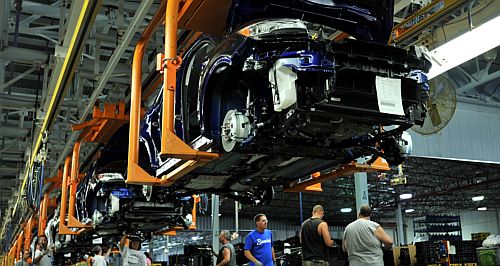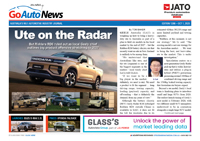Make / Model Search
News - FordElectric ute first from Ford ‘Model T moment’Ford’s $8b platform and production overhaul promises affordable Ranger-size BEV ute15 Aug 2025 FORD Motor Company has unveiled a $US5 billion ($A8b) battery electric vehicle strategy that Ford president and CEO Jim Farley calls the company’s next “Model T moment” – promising affordable BEVs for millions of customers worldwide, likely including Australia.
The announcement has parallels with Volkswagen positioning the ID.3 as its most significant new model since the Beetle and Golf, although the all-electric hatchback has a long way to go in terms of attaining the popularity and iconic status of its forebears.
At the heart of the Ford announcement is a Ranger-sized electric ute targeting a starting price of about $US30,000 ($A46,000) in the United States market, scheduled for a 2027 launch.
Speaking at Ford’s Louisville Assembly Plant in Kentucky, Mr Farley revealed the car-maker’s new ‘Universal EV Platform’ and related manufacturing system described as the most fundamental change to vehicle production since Henry Ford introduced the moving assembly line in 1913.
Ford’s new production process is said to result in 15 per cent faster assembly time while dramatically improving quality – something Ford and its customers will welcome given that so far this year the company has issued 98 recalls in North America alone.
The first of at least eight models built on the new Universal EV Platform will be the ute, with rumours that it will be called Ranchero suggesting it could exist in parallel to the internal combustion and plug-in hybrid Ranger.
Given Ford Australia’s sales volume consists mostly of Ranger utes, the related Everest large SUV and the Mustang sportscar – all of which fall increasingly foul of the federal New Vehicle Efficiency Standard – confirmation that the new platform will spawn "a family of affordable vehicles” could yield significant implications Down Under.
For now, though, Ford Australia remains coy on the matter, issuing a statement that it is “too early to share specifics on export markets today”.
“The exciting new Ford Universal Electric Vehicle Platform enables a family of affordable vehicles to be produced at scale for customers that are fun to drive and digitally advanced,” said a Ford Australia spokesperson.
At the event in Kentucky, Mr Farley was frank about the threat of electric vehicles developed and made by Chinese companies.
“The automotive industry in America is at a crossroads. We're at a crossroads about new technology and new competition from everywhere,” he said.
“We saw this coming for years. We knew that the Chinese would be the major player for us globally.
“Companies like BYD, new start-ups from around the world … They're all coming for us, legacy automotive companies.”
Mr Farley also cited “big tech” companies with designs on the automotive sector as a threat; although Apple famously tried and gave up, Japanese electronics giant Sony is joining the fray and Mr Farley himself publicly endorsed the SU7 electric sedan from Chinese smartphone-maker Xiaomi after driving one for several months.
Ford’s response centres on a California-based skunkworks team that operated in near-total secrecy for three years.
The team, which Mr Farley alluded to in a 2023 earnings call, comprises just a tenth of the personnel typically assigned to such projects and was given unprecedented autonomy to challenge assumptions about vehicle design and manufacturing.
“We had to make a lot of new investments. The unit casting process that you saw – that giant, massive piece of aluminium – comes from very new machines and new processes,” said Ford chief EV, digital and design officer Doug Field, a former Tesla executive who also worked on Apple’s abandoned car project.
“But when you build a vehicle that way, if you just look at the body and compare it to a traditional pick-up, three quarters of the parts are gone. It has one quarter of the parts. Two thirds of the welds are gone, and half of the fasteners are gone.”
The wiring harness in the new ute will be more than 1.3km shorter and 10kg lighter than Ford’s first-generation electric SUVs, which drew criticism for having what some saw as needlessly complex electrical and cooling systems.
Ford says the new platform also enables 40 per cent fewer workstations in the production plant.
Mr Field also claimed that the new platform can achieve the same driving range with a third less battery capacity than typical first-generation electric vehicles.
“That’s the kind of ingenuity we need to compete with the Chinese,” he said.
“Are we going to compete on labour to make batteries? No. But if we use our brains to have a third-smaller battery, we can compete.”
To achieve production efficiencies, Ford developed what it calls an “assembly tree” formation which, instead of a single continuous line, builds each vehicle in three parallel sub-assemblies that converge at the final stage.
Large single-piece aluminium castings, similar to those pioneered by Tesla, replace dozens of smaller parts.
The front and rear of the vehicle are assembled separately before being attached to a structural battery pack which also serves as the vehicle’s floor, pre-assembled with seats, consoles and carpeting.
Ford says the new method also aids worker ergonomics and safety, claiming an 84 per cent reduction in reaches over the front fender, 63 per cent less vehicle ingress for workers, and more than 60 per cent improvement in overhead reaching.
“We put our employees at the centre and re-created the factory from scratch,” said Ford vice president of Americas manufacturing Bryce Currie.
“We live and breathe continuous improvement, but sometimes you need a dramatic leap forward.”
The company is spending approximately $A3 billion to transform Louisville Assembly Plant, securing 2200 hourly jobs.
Another $A4.6billion is being invested in BlueOval Battery Park Michigan, America’s first facility to produce lithium iron phosphate prismatic battery cells, creating 1700 jobs.
Combined with related investments, Ford’s commitment totals approximately $A8 billion and nearly 4000 jobs in the United States.
“Our competitors build their affordable vehicles in South Korea and Japan and import them, but not us at Ford,” declared Mr Farley.
“We made a big bet on our country, and we made a huge bet on the state and the Commonwealth of Kentucky.”
Jingoism aside, Louisville will likely be just one of several production sources for vehicles that Ford wants to sell significant numbers of worldwide, raising questions about where models based on the Universal EV Platform for Australia and other export markets might be manufactured.
The announcement also puts the role of Ford’s substantial Australian design and engineering operations under a spotlight, given it is currently responsible for the ladder frame platform that underpins the big-selling Ranger and Everest.
Ford’s new architecture and production method accommodates various body styles and configurations, from compact cars to large SUVs and commercial vehicles, all sharing common components and manufacturing processes.
The ute will reportedly accelerate as quickly as a Mustang EcoBoost, with the handling benefits of a low centre of gravity provided by its floor-mounted battery pack.
Ford claims lower five-year ownership costs than a three-year-old used Tesla Model Y.
“We took inspiration from the Model T – the universal car that changed the world,” explained Mr Field.
“We assembled a really brilliant collection of minds across Ford and unleashed them to find new solutions to old problems. This isn't a stripped-down, old-school vehicle.”
Cobalt- and nickel-free lithium iron phosphate batteries with prismatic cells manufactured in the US rather than imported from China are said to offer improved durability and lower costs while serving as a structural element of the vehicle.
Attending the announcement, Kentucky governor Andy Beshear drew historical parallels.
“Just like Henry Ford entrusted Kentucky to build his Model T a century ago, today Jim Farley and chairman Bill Ford are putting that same trust in us once again,” he said.
The announcement comes at a critical juncture for Ford’s electric vehicle strategy. The company lost more than $8 billion on BEVs last year, with similar losses the year before and more red ink predicted for 2025.
“We have all lived through far too many 'good college tries' by Detroit automakers to make affordable vehicles that ends up with idled plants, layoffs and uncertainty,” added Mr Farley.
“So, this had to be a strong, sustainable and profitable business.”
Acknowledging the risks involved, Mr Farley admitted: “There are no guarantees with this project. We're doing so many new things I can't tell you with 100 per cent certainty that this will all go just right. It is a bet. There is risk”.
Union support appears strong, with UAW vice president Laura Dickerson and local chair Brandon Reisinger praising the focus on ergonomics and job security during the announcement.
“It’s clear that this product and the plant is going to be designed more around the employees,” said Mr Reisinger.
“We should have a healthier workforce, should be able to go home to your families and not be sore at the end of the day.”
Ford promises advanced software capabilities with over-the-air updates that will continuously improve vehicles after purchase. The company’s new zonal electrical architecture enables features “the industry has never seen”, according to Mr Field.
“Success is not guaranteed. When you take these kinds of risks, you sign up for a whole hell of a lot of work, and we're going to need all of your help. But I know Ford is the company that can and will pull this off,” concluded Mr Farley.  Read more8th of July 2025  Emissions regulations drive up Mustang priceFord increases the list price of its Mustang sportscar to cover NVES emissions penalties17th of June 2025  More Ford PHEVs as NVES price hikes ruled outFord set to double down on electrified portfolio to reduce CO2 emissions under NVES17th of June 2025  Plug-in hybrid Ford Ranger Raptor is possibleFord hints at plug-in Raptor to slash CO2, avoid NVES fines and boost capability |
Click to shareFord articlesResearch Ford Motor industry news |











Facebook Twitter Instagram